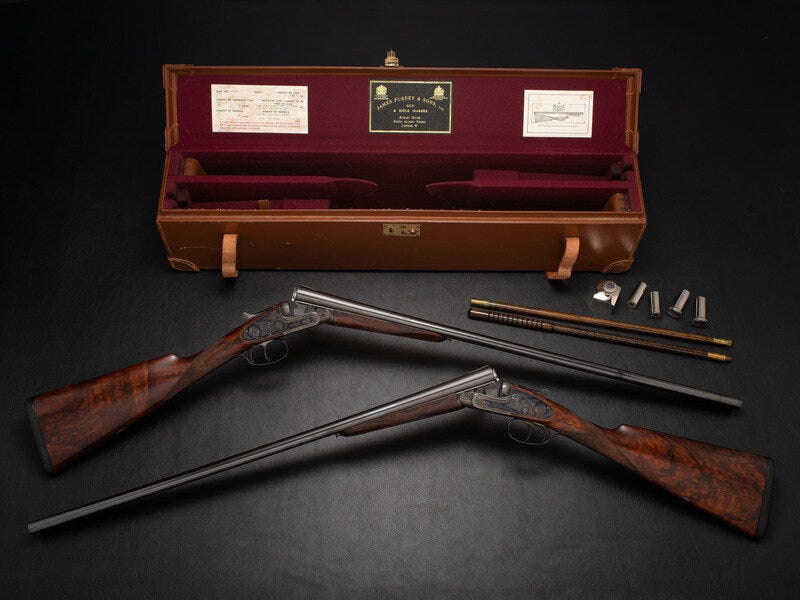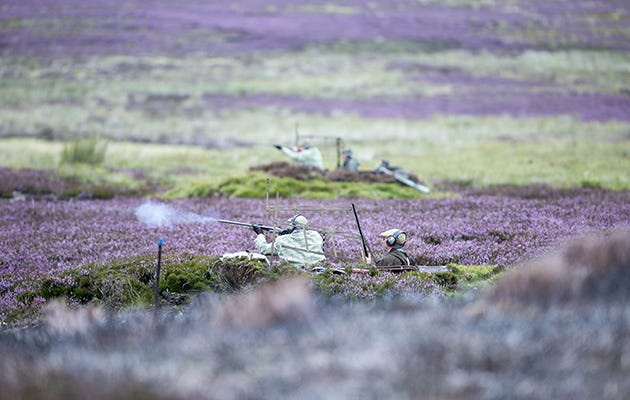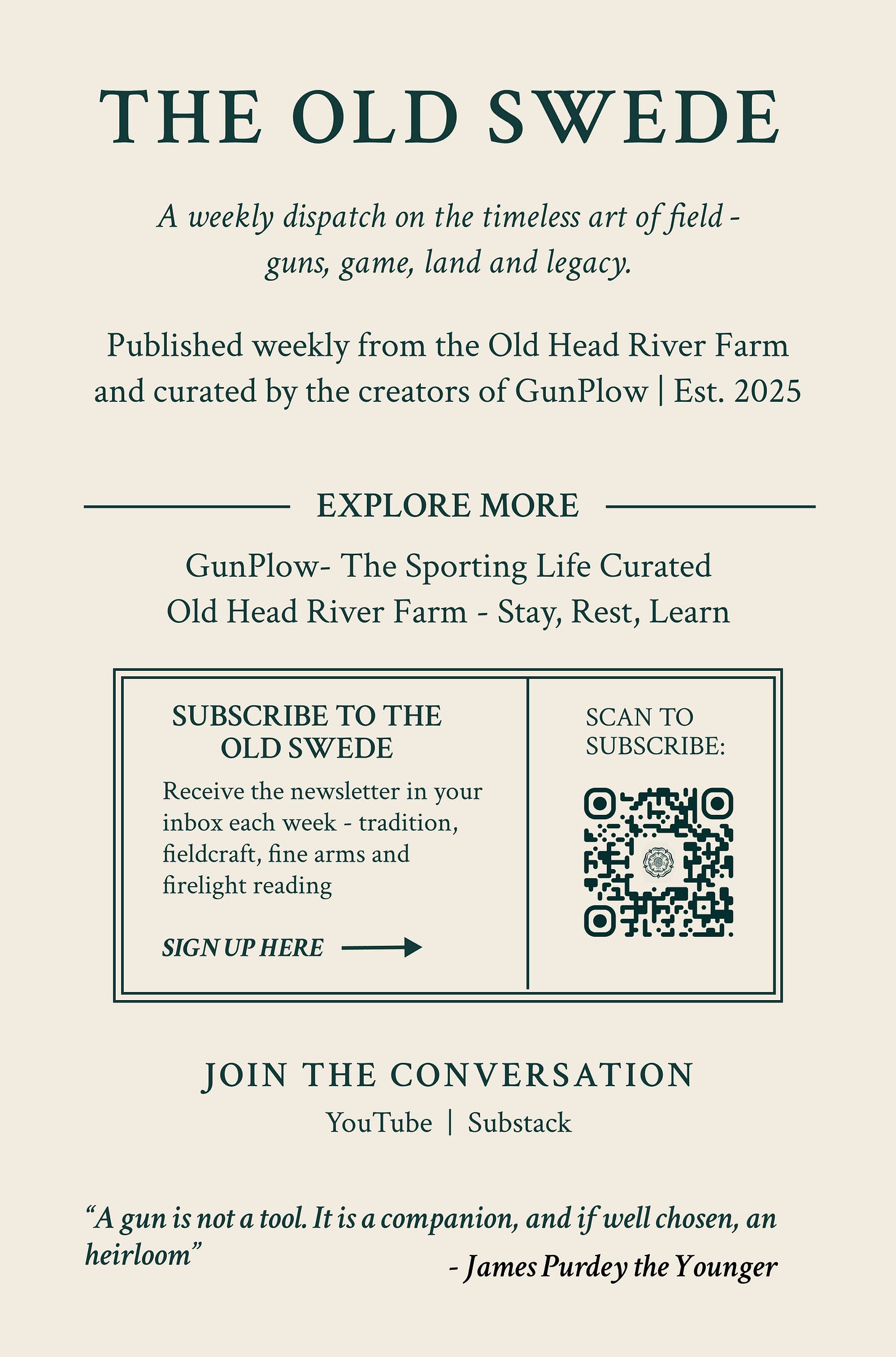The Old Swede: August 11, 2025
The Guns and The Ground: From heathered ridges to the first rise of the season.
The Glorious 12th — Why It Matters
August 12th — The Glorious 12th — marks the official start of the red grouse shooting season across the UK. Unlike other gamebirds, the red grouse is entirely wild, thriving only on Britain’s upland heather moors. There is no pen-rearing or release; each bird is the product of meticulous moorland management and the shifting moods of weather, predator control, and habitat rotation.
The date itself is fixed by law under the Game Act of 1831, ensuring birds have completed breeding and are strong on the wing. For keepers and Guns alike, it is the culmination of a year’s work — controlled heather burning, vermin control, and predator protection.
The day carries both sport and symbolism. On the morning of the 12th, butts across Scotland, Yorkshire, and the North Pennines fill with anticipation. The first covey over the line signals not just the start of a season, but the return of a centuries-old ritual — a fusion of conservation, community, and competition.
From Highland estates to Yorkshire moors, the Glorious 12th is a touchstone of British sporting culture: the finest birds in the wildest places, on the first day they are legal to take.
Featured Gunmaker
The Perfect Pair of Grouse Guns
A “perfect pair” of grouse guns is more than matched serial numbers — it’s balance, speed, and instinct all working together. Traditionally, these are best London sidelock ejectors, built to the same specifications so a Gun can swap seamlessly between them, reloaded by a skilled loader during a drive.
For grouse, lightness and handling are paramount. Pairs are usually 12-bores with 26 to 28 inch barrels, open choked (¼ and ½ or less) for fast, instinctive shooting at low, hard-crossing birds. Weight hovers around 6½ lbs for quick mount and recovery.
Makers such as James Purdey & Sons, Holland & Holland, and Boss & Co. still produce bespoke pairs, though many vintage pairs from the interwar years remain in active service. The finest pairs have perfectly matched wood grain, identical trigger pulls, and consistent point of impact — giving the shooter confidence that every second gun feels like the first.
To own a perfect pair is to carry both history and engineering in your hands, built not for display but for the most exhilarating shooting the British Isles offers.
Shooting School
The Grouse Butts at West London Shooting School
At West London Shooting School, the grouse layout is legendary. Located on ‘Sharvel Moor’ at the West London Shooting Grounds, they utilize their purpose-built line of grouse butts, to replicate the angles, speed, and unpredictability of driven grouse before the long journey north for the real thing.
The school’s instructors emphasize safety, etiquette, and all of the shooting skills required to provide forward allowance and muzzle control, key for low, fast birds. Targets skim just above the butt wall, forcing the Gun to practice mounting low and swinging through without putting neighboring guns in danger.
They also teach flank awareness, reading the drive line, and working with a loader in tight quarters. For visiting sportsmen heading to Yorkshire or the Highlands, a few sessions here can mean the difference between scratching and clean, confident shooting on the moor.
The Grouse Course at West London Shooting School
Feature Estate Visit
Famous Grouse Shooting Estates
The great moors of Northern England and Scotland host some of the most celebrated grouse shooting grounds in the world. In Yorkshire, estates like Coverhead Estate and Swinton Park in the North Yorkshire region deliver unprecedented shooting experiences.
Across the border, Scotland’s Highlands boast legendary beats such as Invercauld, Glen Clova, and Drumlanrig, where the scale of the scenery is matched only by the challenge of the birds. The North Pennines and Angus Glens are equally famed, producing days where coveys rise in waves across the heather.
These estates are as much about heritage as sport. Many have been in the same families for centuries, with keepers passing down local knowledge through generations. Days here are limited and highly sought after, with many booked years in advance.
Each moor is unique — from the height of the heather to the width of the drives — but all share the same heartbeat: wild birds, skilled keepers, and the rhythm of a day that begins with the sound of beaters’ sticks and ends in the camaraderie of the lodge.
Gun Dogs
The Importance of Dogs in Walked-Up Grouse Shooting
In walked-up grouse shooting, dogs are not an accessory — they are essential partners. Spaniels and setters work ahead of the Guns, quartering the heather, scenting the wind, and flushing birds within range. Without them, locating and moving wild grouse efficiently over vast moorland would be nearly impossible.
Pointers and setters excel in the open expanses, indicating birds from distance and allowing the line to approach before the flush. Springer and cocker spaniels are masters of the closer flush, especially in thicker heather or mixed cover.
The bond between handler and dog is tested constantly. Dogs must be steady to wing and shot, mark downed birds instantly, and retrieve cleanly, often across difficult, boggy terrain. In walked-up days, every bird is earned step by step, and the dogs’ work is often the most memorable part of the outing.
Fieldcraft Highlight
The Safety and Etiquette of Grouse Butt Sticks
In driven grouse shooting, butt sticks are a matter of safety, etiquette, and tradition. Placed in the ground on each side of the butt, these sticks act as visual markers for safe shooting angles, ensuring Guns keep their muzzles clear of the line.
The rule is simple: never swing through the butt sticks. Shots are taken in front or directly overhead, and anything behind. This preserves not only the safety of fellow Guns, beaters, and flankers, but also the etiquette of leaving birds for neighboring butts.
Positioning is equally important. Keep the sticks upright and visible before each drive. If wind or ground makes them unstable, adjust them with your loader.
On the moor, where excitement can run high and birds low, these simple hazel poles are a quiet reminder: safe shooting ensures another season to come.
Shoot Lunch & Wine Pairing
A Perfect Grouse Moor Lunch
A proper grouse moor lunch balances warmth, comfort, and field practicality. Served either in a stone bothy or a canvas lunch tent, it begins with grouse broth — rich, sustaining, and flavored with thyme and barley.
The main might be game pie with hot water crust, served alongside pickled red cabbage and buttered new potatoes. For dessert, cranachan — raspberries, toasted oats, honey, and whisky cream — provides sweetness with a Highland nod.
To drink, a 2015 Château Batailley Pauillac offers dark fruit, cedar, and enough structure to pair with game’s richness. Coffee and a tot of sloe gin close the meal before the afternoon drives.
A moorland lunch isn’t just a pause — it’s a celebration of the land, the birds, and those who make the day possible.
Quote from the GunPlow Library
“Each day on the moor is different. The light changes, the wind shifts, and the birds read it before you do. Success is never guaranteed, and therein lies the beauty. The moor teaches patience, humility, and the truth that the best days are often those when the bag is light, but the heart is full.”
— from A Year on the Moor by Tarquin Millington-Drake
GunPlow Classic Library Coming Soon






